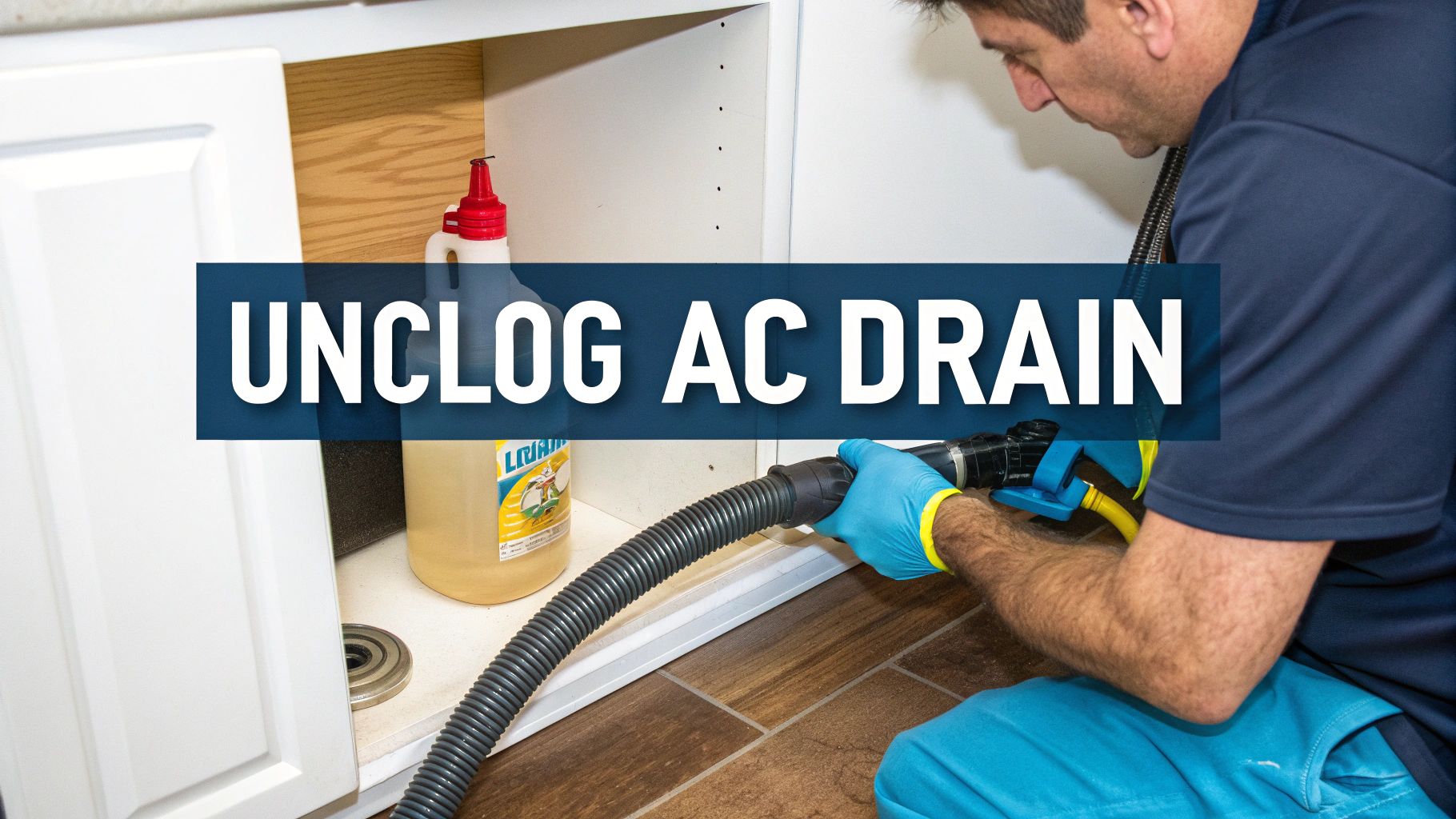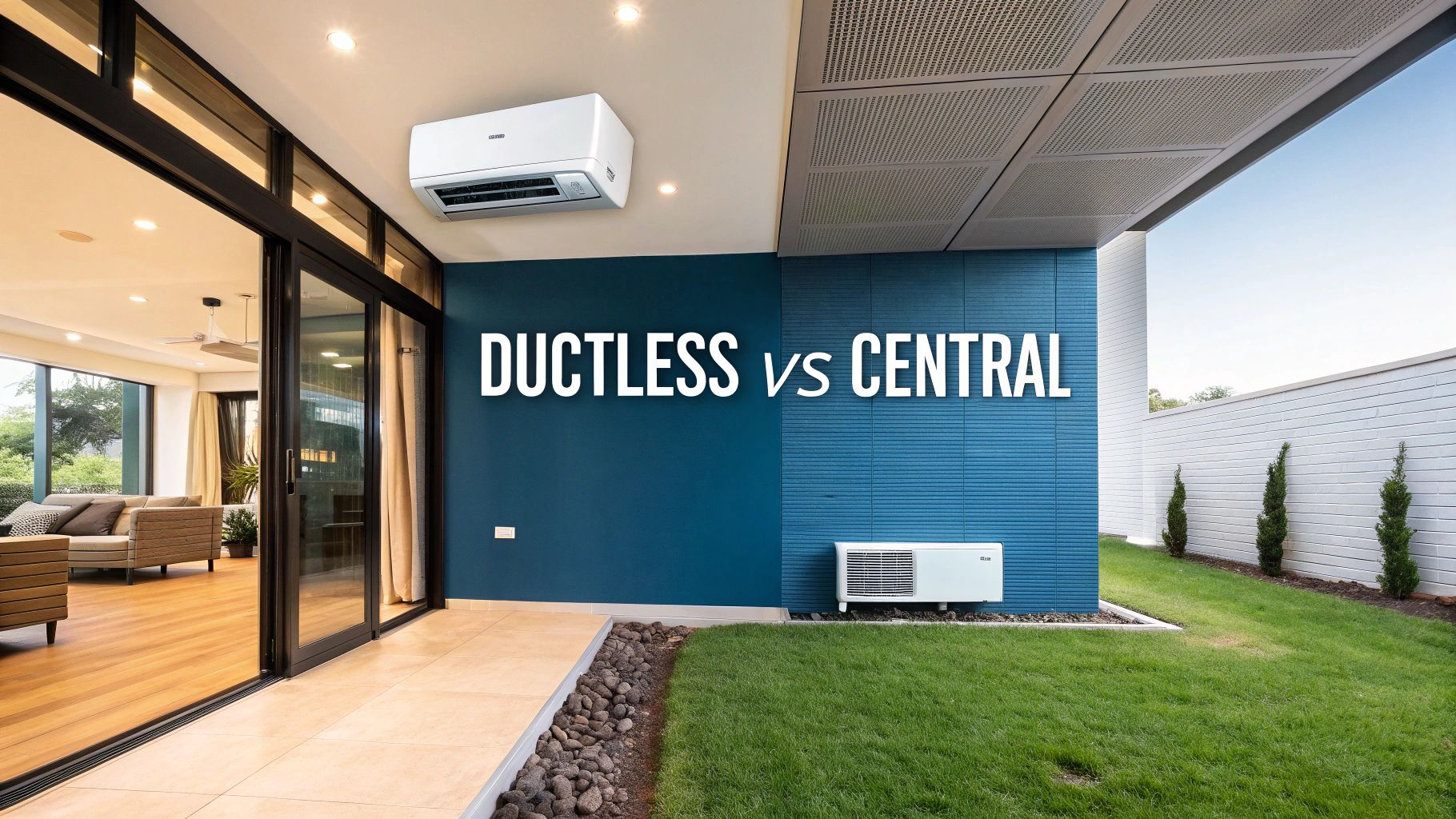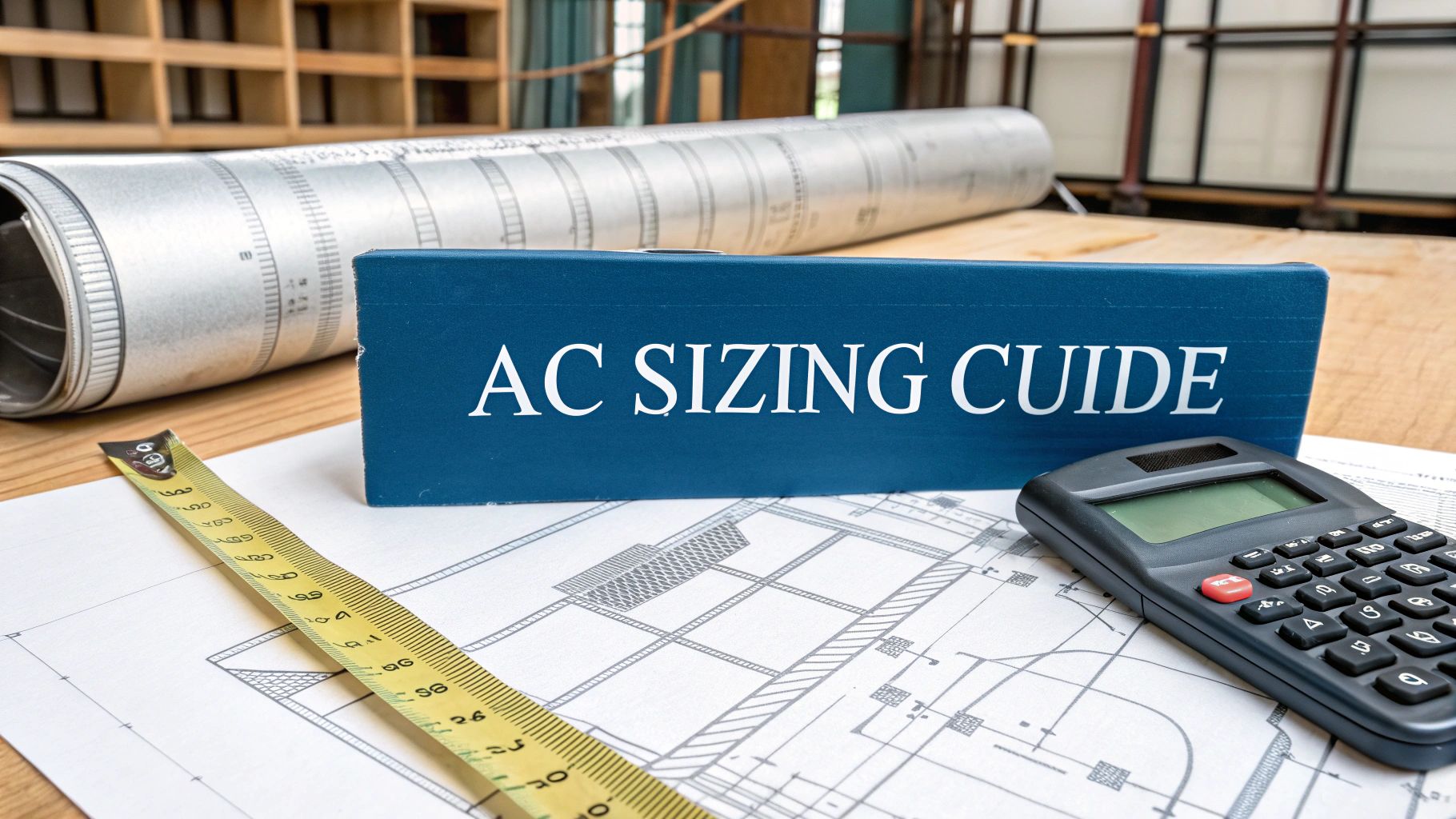That musty smell in the hallway or the surprise puddle of water by your indoor AC unit isn't just a minor annoyance. It's a smoke signal. Your air conditioner's job is not just to cool, but to pull humidity out of the air. All that moisture has to go somewhere, and it travels through a simple PVC pipe called a condensate drain line.
When that line gets clogged, the water backs up, and that’s where the real trouble begins.
Why AC Drain Lines Clog and Why It Matters
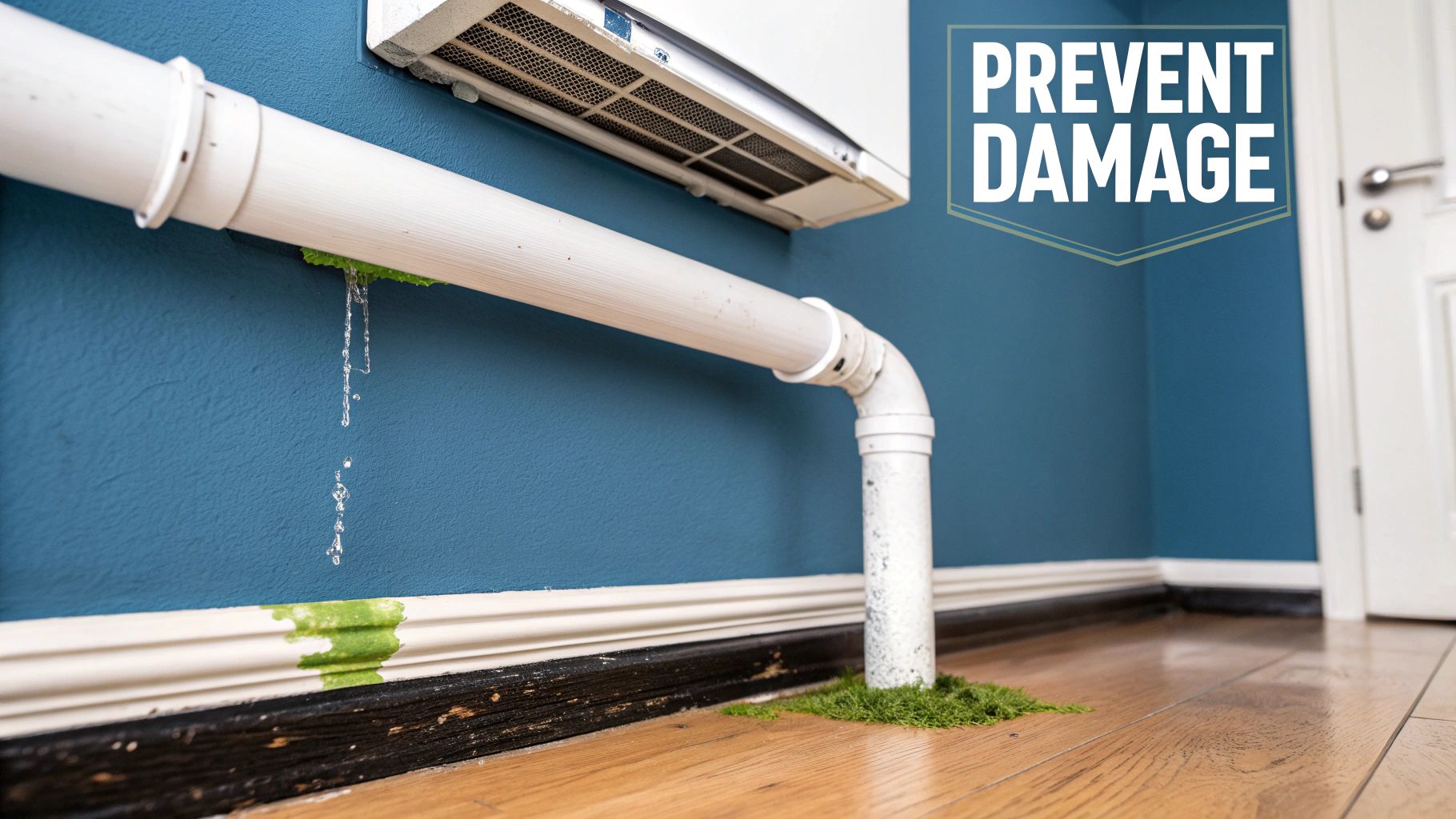
The constant flow of water in a dark, enclosed pipe is the perfect recipe for a blockage. It's an issue I see all the time, especially in humid climates.
The Anatomy of a Clog
A clog doesn't just appear out of nowhere. It's a gradual buildup of gunk that finds its way into your HVAC system—think of it like a slowly blocking artery for your home’s cooling system.
The most common culprits are pretty simple:
- Dust and Debris: Your system is constantly pulling in air, and with it comes dust, pet dander, and other tiny particles. This stuff mixes with the condensation and eventually forms a thick, nasty sludge.
- Algae and Mold: It’s dark and damp inside that drain line, making it a five-star resort for algae and mold. They grow into a slimy biofilm that can completely choke off the water flow.
- Insects and Nests: It’s not uncommon for small bugs or wasps to decide the outdoor end of your drain line is the perfect place to build a home, creating an instant dam.
A clogged drain line isn't just an inconvenience; it's a direct threat to your home's structure and your family's health. Ignoring the initial signs can lead to cascading problems that are far more expensive and difficult to resolve.
The Domino Effect of a Blocked Drain
What starts as a small blockage can escalate in a hurry. A standard AC unit, especially in a humid area, can produce 5 to 20 gallons of water every single day.
When that water has nowhere to go, it overflows the drain pan. I’ve seen it cause thousands of dollars in damage to ceilings, drywall, and hardwood floors. Worse yet, all that excess moisture creates the perfect environment for mold to grow in your walls, which can seriously impact your home's air quality and trigger respiratory issues. You can learn more about the silent threat of AC drain line clogs and their potential impact.
Your Toolkit and Safety Checklist
Before you roll up your sleeves and dive into unclogging that AC drain line, let's get your gear in order. Trust me, having everything you need within arm's reach from the start saves you a world of frustration and a couple of trips back to the hardware store.
Think of it as setting up your workspace. A little prep now makes the whole job go smoother and faster.
What You'll Need to Get Started
We’re not talking about a truckload of professional equipment here. For most clogs, a few common household items will do the trick perfectly.
Here's a quick rundown of what I recommend having on hand before you begin.
| Tool or Material | Primary Use | Where to Find |
|---|---|---|
| Wet/Dry Vacuum | Sucking out stubborn clogs and water from the drain line. | Hardware stores, home improvement centers, or maybe your garage. |
| Duct Tape | Creating an airtight seal between the vacuum hose and the pipe. | Most hardware, grocery, or big-box stores. |
| Distilled White Vinegar | Flushing the line to dissolve algae, mold, and gunk. | Any grocery store. |
| Rags or Paper Towels | Cleaning up spills and wiping down components. | Your kitchen or utility closet. |
Having these items ready will make the process much more efficient.
The Most Important First Step: Safety
Okay, let's talk about the one thing you absolutely cannot skip. Before you touch a single part of your HVAC system, you need to cut the power. I can't stress this enough.
Shut off all power to your HVAC unit at the circuit breaker. This isn't just a friendly tip; it's a critical safety measure to prevent serious electrical shock.
Head to your home's breaker panel and find the switch labeled for your "AC," "Air Handler," or "Furnace." Flip it to the OFF position. For good measure, I always recommend turning the system off at the thermostat too. It’s a simple double-check that ensures there's zero chance the unit could kick on while you’re working.
Clearing the Clog From Your AC Drain
Alright, with the power safely off and your gear at the ready, it's time to get to the main event: clearing that stubborn clog. The game plan is pretty simple. We'll suck the blockage out from the outside, then give the line a good flush from the inside to make sure it's completely clear.
First things first, you need to know where you're working. You’re looking for two ends of the condensate drain line. Inside, you'll typically find a T-shaped PVC pipe with a cap on it, located right near your air handler (check the attic, garage, or a utility closet). The other end is outside, usually a simple PVC pipe sticking out of the wall near your condenser unit. This is where you'd normally see water dripping when your AC is running hard.
Before you touch anything, a quick safety check is non-negotiable. This visual guide walks you through it.
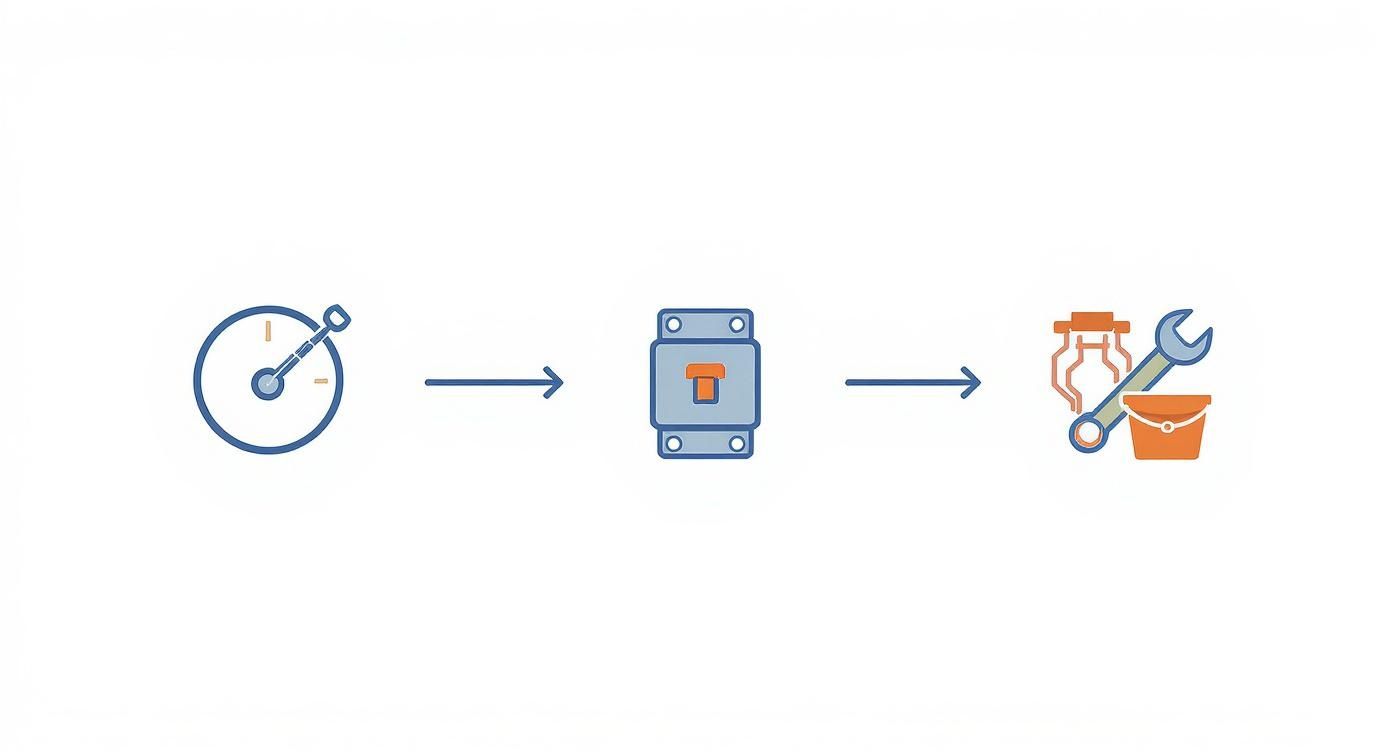
Stick to these steps, and you can work on your system without worrying about it kicking on or giving you a nasty surprise.
Pulling Out the Gunk With a Wet/Dry Vac
In my experience, the best way to tackle a clog yourself is to pull it out with a wet/dry vacuum. It’s effective and surprisingly easy.
Head outside to the drain line exit. You’ll want to create a really tight seal between the vacuum hose and the pipe. I usually just press the hose firmly against the opening and wrap my hand around it to close any gaps, but a few wraps of duct tape work wonders, too.
Fire up the vacuum and let it run for a solid minute or two. The suction is incredibly powerful and, in most cases, will pull all that built-up sludge and gunk right out. Trust me, hearing that clog finally get sucked into the vacuum canister is one of the most satisfying sounds a homeowner can hear.
Once you’re done outside, go back to the indoor access point. Pop the cap off and take a look. If you see any standing water in the drain pan, just use your vac to suck it all out before you move on.
The Vinegar Flush for a Final Clean
Now that the main blockage is gone, you need to flush the line to get rid of any lingering residue.
Slowly and carefully pour about one cup of distilled white vinegar down the indoor access pipe. Now, just let it sit. Give it at least 30 minutes to work its magic, dissolving any gunk or algae that the vacuum might have missed.
A Quick Word of Caution: Steer clear of bleach. I know it’s tempting, but it can corrode the metal fins on your evaporator coils and even damage the PVC pipes over time. Vinegar is just as effective and much safer for your system.
After the vinegar has had time to sit, flush the line by pouring about a gallon of warm water down that same access point. If you did everything right, you should see it flowing freely out of the pipe outside. Success!
Of course, a clean drain line is only one part of the puzzle. Keeping your evaporator coils clean is just as important for preventing future clogs. You can find our step-by-step instructions in this guide on how to clean air conditioning coils. And for those really tough blockages that just won't budge with a vacuum, you might need to explore other techniques, like using a handheld snake for drain clogs.
Keeping Your Drain Clear With Simple Maintenance
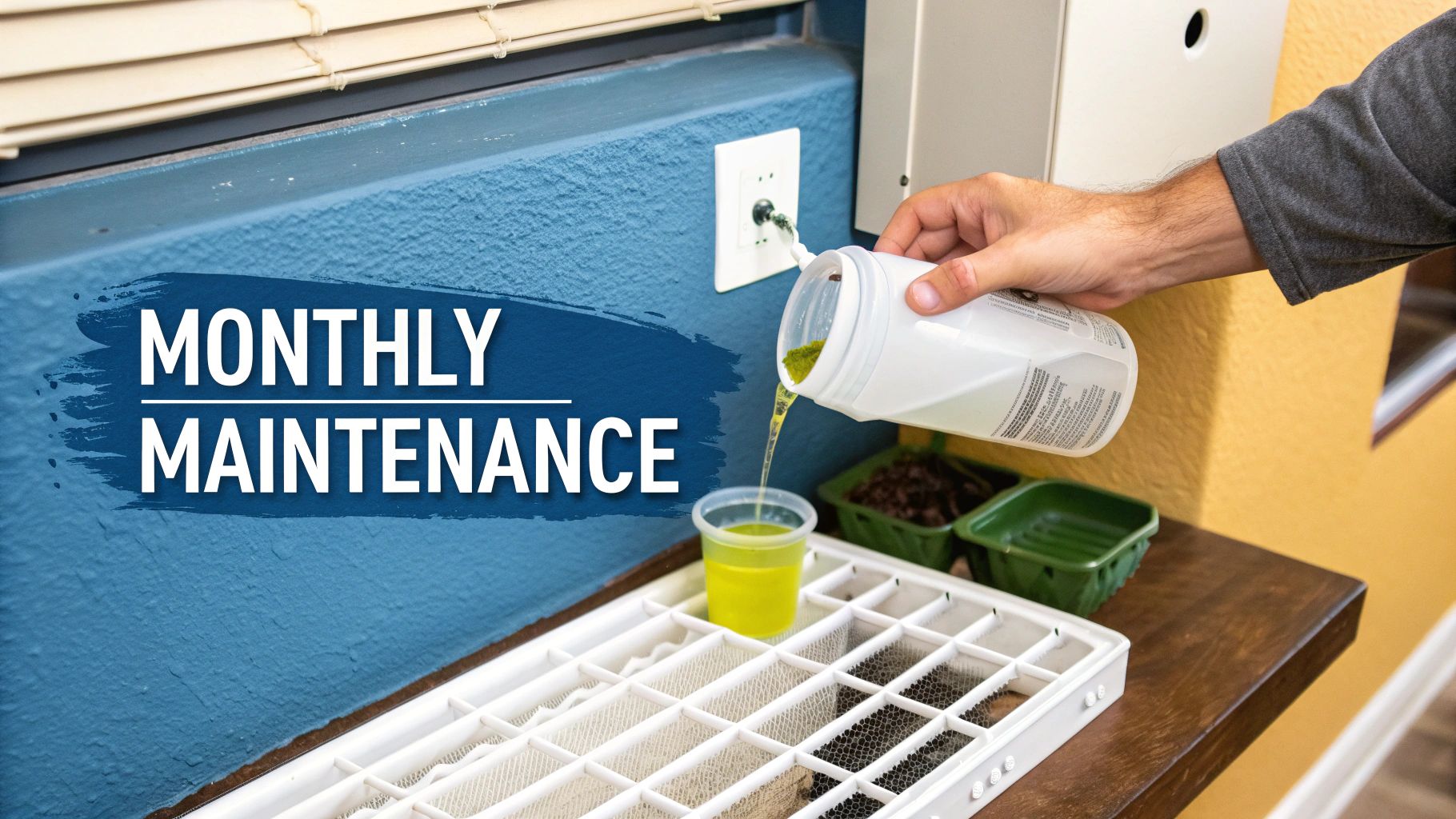
It feels good to clear a nasty clog, but the real victory is making sure you never have to do it again. A little bit of proactive maintenance is your best weapon against future water damage, annoying service calls, and the hassle of going through this whole process twice.
Honestly, just a few minutes of your time each month can save you from a major headache and a hefty repair bill down the line. It's all about simple, consistent care.
Your Monthly Maintenance Routine
When your AC is running constantly during those hot summer months, a quick vinegar flush should be on your to-do list. This is the easiest way I know to stop algae and slime from ever getting a foothold inside your drain line.
Here’s the simple recipe for success:
- Grab some distilled white vinegar and pour one cup down the indoor access point.
- Just let it sit for about 30 minutes. This gives the vinegar time to work its magic and dissolve any gunk that's starting to build up.
- Afterward, flush it all out with a gallon of warm water.
That's it. This small step completely messes up the environment that clogs love, ensuring water can flow out freely.
It's a surprising fact, but industry data shows that almost 80% of AC service calls in the spring are because of clogged drain lines. That statistic alone shows you how a little bit of prevention can save you a lot of money on emergency repairs.
The First Line of Defense: Your Air Filter
You might not think your air filter has much to do with your drain line, but they're absolutely connected. When your filter is dirty and clogged, it can't stop dust, pet hair, and other debris from getting sucked right into your AC system.
That gunk eventually mixes with the condensation on the evaporator coils, forming a thick sludge that’s the primary culprit behind drain clogs.
Checking your filter every month and changing it when it’s dirty is one of the most powerful things you can do. A fresh filter keeps your drain line clear, improves your indoor air quality, and even helps your AC run more efficiently. To see all the other little things that make a big difference, take a look at our complete HVAC preventive maintenance checklist. These are the simple habits that lead to a reliable, long-lasting cooling system.
Knowing When to Put Down the Tools and Call a Pro
While knowing how to clear your AC drain line is a fantastic skill for any homeowner, recognizing your limits is just as crucial. Sometimes, pushing forward with a DIY fix can turn a small issue into a major headache with an expensive repair bill to match.
If you’ve given it your best shot with the shop vac and the vinegar flush but that standing water just won't budge, it’s time to stop. You're likely dealing with a deep, compacted clog that needs more than just basic tools. A pro has specialized equipment that can break it up without cracking your delicate PVC pipes.
Red Flags That Mean You Need an Expert
There are a few tell-tale signs that the clog is actually a symptom of a bigger problem. Ignoring these can lead to serious damage.
Watch out for these warning signs:
- The Clog Keeps Coming Back: Does the drain line back up every few weeks? This isn't normal. It could point to an underlying issue, like an improperly sloped drain line or a system that's producing an unusual amount of gunk. A technician needs to diagnose the root cause.
- You See Major Water Damage: Brown water stains on your ceiling or puddles forming around your indoor air handler are serious red flags. A professional can track down the true source of the leak and assess the extent of the damage before it gets worse.
- The System Won't Turn On: You’ve cleared the line, flipped the breaker, but the AC still won't kick on. This often points to a problem with the float switch or another electrical component that got tripped or damaged. It's best to let a certified technician handle any electrical troubleshooting.
If you’ve tried the DIY route and failed, or you're seeing signs of recurring clogs and water damage, it’s time to call for backup. For really tough blockages, professional drain cleaning services have the high-powered tools to get the job done right.
If you're dealing with other system-wide issues, our air conditioning troubleshooting guide is a great resource to help you figure out what might be going on before you pick up the phone.
FAQs: What to Know About Your AC Drain Line
Let's run through some of the questions I hear all the time from homeowners dealing with a backed-up AC drain line. A little bit of knowledge here can save you a ton of headache—and an emergency call on a hot Saturday.
How often should I clean my drain line?
This is easily the most common question. When your AC is running nonstop during the peak of summer, you should give it a quick flush once a month. That’s all it takes. Just pour a cup of distilled white vinegar down the access line every 30 days or so. This simple step will stop most of that nasty gunk and algae from ever taking hold.
Can I use bleach instead of vinegar?
I get this one a lot, too. While it seems like a good idea, bleach is just too corrosive for your HVAC system. It can eat away at metal parts, like your delicate evaporator coils, and can even degrade the PVC pipe itself over the long haul. Stick with vinegar—it's safer and gets the job done without risking damage to your equipment.
What are the first signs of a clog?
You don't want to wait until you see a puddle on the floor. The earlier you catch a clog, the easier it is to fix. Keep an eye out for these subtle clues:
- Standing water in the drain pan: This is the most obvious sign. If you look at your indoor unit and see water just sitting in the pan underneath it, you've got a drainage problem.
- A musty, mildew smell: Getting a whiff of something damp and funky near your indoor unit or coming from your vents? That's often the first sign that water isn't draining properly and is starting to grow mold or mildew.
- Your house feels humid: If your home feels muggy and damp even with the AC on, a clog could be the culprit. A blocked line interferes with the system's ability to pull humidity out of the air.
I always tell people that a quick monthly peek at the drain pan is the single best thing you can do. Catching a clog early prevents a minor issue from becoming a costly water damage nightmare.
Spotting these signs lets you get ahead of the problem, usually before the overflow switch trips and shuts your entire system down. It’s all about being proactive to keep your home cool and dry.
If you’ve given it a shot and the line is still blocked, or if you'd just rather have a professional handle it, Florida Cooling Group is ready to help. Our technicians have the right tools and know-how to clear any clog quickly and correctly. Schedule your service with us today!

 (561) 400-2205
(561) 400-2205